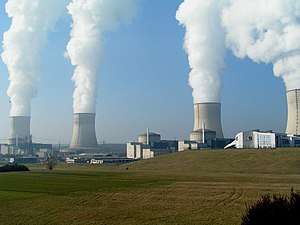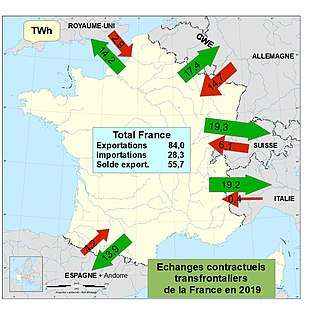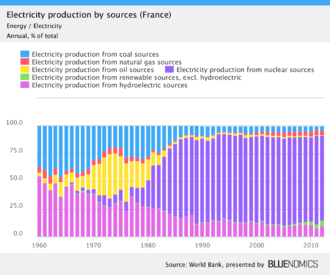Electricity sector in France
The electricity sector in France is dominated by nuclear power, which accounted for 71.7% of total production in 2018, while renewables and fossil fuels accounted for 21.3% and 7.1%, respectively[1] (compare to 72.3% nuclear, 17.8% renewables and 8.6% fossil fuels in 2016).[2] France has the largest share of nuclear electricity in the world. France's electrical grid is part of the Synchronous grid of Continental Europe and it is among the world's biggest net exporters of electricity. The French nuclear power sector is almost entirely owned by the French government.
 |
|
 | |
| Left: The Cattenom nuclear power station near Luxemburg Right: Wind power in France; turbines in Lower Normandy Bottom: The Cruas nuclear power plant at night. | |
Consumption
In 2008 consumption of electricity was on average 8,233 kWh/person. This corresponded to 110% of the EU15 average (7,409 kWh/person) and 91% of the OECD average (8,991 kWh/person).[3]
Electricity per person and by power source
| Use | Production | Export | Exp. % | Fossil | Nuclear | Nuc. % | Other RE* | Bio+waste | Wind | Non RE use* | RE %* | |
|---|---|---|---|---|---|---|---|---|---|---|---|---|
| 2004 | 8,204 | 9,203 | 999 | 12.2% | 849 | 7,209 | 87.9% | 1,061 | 83 | 7,060 | 13.9% | |
| 2005 | 8,215 | 9,176 | 961 | 11.7% | 970 | 7,201 | 87.7% | 924 | 81 | 7,210 | 12.2% | |
| 2006 | 8,140 | 9,041 | 901 | 11.1% | 897 | 6,977 | 85.7% | 1,083 | 85 | 6,972 | 14.3% | |
| 2008 | 8,233 | 8,984 | 751 | 9.1% | 853 | 6,872 | 83.5% | 1,168 | 91 | 6,974 | 15.3% | |
| 2009 | 7,951 | 8,351 | 400 | 5.0% | 871 | 6,371 | 80.1% | 897* | 93 | 121* | 6,840 | 14.0% |
| * Other RE is waterpower, solar and geothermal electricity and wind power until 2008 * Non RE use = use – production of renewable electricity * RE % = (production of RE / use) * 100% Note: European Union calculates the share of renewable energies in gross electrical consumption. | ||||||||||||
Mode of production
.png)
French gross production of electricity was 557 terawatt-hours (TWh) in 2014,[5]:27 slightly down from 570 and 567 TWh produced in 2008 and 2004, respectively. France is the world's 9th largest producer of electricity.[5]:27[6] France is also the world's second largest producer of nuclear electricity, behind the United States and ahead of Russia and Korea. In terms of nuclear's share on the total domestic electricity generation, France has by far the highest percentage portion of any country in the world (78.4% in 2014, also see chart "Electricity production by source").[5]:17
Nuclear power
The French nuclear power is almost entirely owned by the French government and its electricity is sold to the government. According to Al Gore the degree of the government subsidy is difficult to ascertain because of a lack of transparencies in the finances of the operation.[7]
The Commissariat à l’Énergie Atomique is the national authority in France. Nuclear companies include EdF and Areva. Électricité de France (EdF) is the main electricity producer. Eurodif is the uranium enrichment plant. Areva NC (France) and Rio Tinto (UK) are the top uranium companies of the world.
In 2010, as part of the progressive liberalisation of the energy market under EU directives, France agreed the Accès régulé à l'électricité nucléaire historique (ARENH) regulations that allowed third party suppliers access up to about a quarter of France's pre-2011 nuclear generation capacity, at a fixed price of €42/MWh from 1 July 2011 until 31 December 2025.[8][9][10]
France has the largest share of electricity from nuclear power in the world. According to the IEA 77% of its domestic electricity was generated by nuclear power in 2013. The second was Belgium 52.1%, third Slovakia 51.7% and followed by Hungary 50.7%, Ukraine 43.6%, Sweden 42.7%, Switzerland 36.4%, the Czech Republic 35.9%, Slovenia 33.6% and Finland 33.3%[11] France's nuclear reactors comprise 90 percent of EDFs capacity and so they are used in load-following mode and some reactors close at weekends because there is no market for the electricity.[12][13] This means that the capacity factor is low by world standards, usually in the high seventies as a percentage, which is not an ideal economic situation for nuclear plants.[12]
In terms of installed capacity and produced power in 2013 France was the second largest producer of nuclear energy in the world behind the United States. Installed nuclear capacity was 63.1 GW and power production 403.7 TWh.[11]
France reprocesses its nuclear waste to retrieve plutonium and uranium for use as additional fuel. Fission products are stored in La Hague facility until a deep geological repository for high-level waste can be constructed. A repository for low-level and short-lived intermediate-level nuclear waste is already operational.[14]
The European Pressurized Reactor (EPR) at Flamanville, the first new nuclear reactor to be built in France in 15 years, as of 2012 was expected to open in 2016 instead of the original starting date of 2012, with costs climbing to €8.5bn instead of the original estimate of €3.3bn.[15] Further delays have since pushed the opening to at least late 2022.[16]
Hydro power
Installed hydro electricity power capacity was 25 GW in 2014, and hydro generation was 69 TWh (ranked 10th in the world). Hydro share in total domestic electricity generation was 12.2%.[5]:19
Wind power
Installed wind power in France was 5,660 MW at the end of 2010 and 4,574 MW at the end of 2009. The share of wind power in the end of 2010 was in average 2.3% of electricity need.[17]
In 2013 electric energy from wind power in France was only produced in onshore wind farms. However, on 25 January 2011, President Nicolas Sarkozy confirmed the tendering process to build France's first five offshore wind farms, expected to have a capacity of 3GW and to be sited off the Atlantic coast between Saint-Nazaire and Dieppe/Le Tréport.[18][19] Tender documents were to be sent out on 1 April, with the winning bid announced in early 2012.[19] A second round of bidding to provide a further 3GW of capacity is expected in 2012.[19]
| No | Country | 2012 | 2011 | 2010 | 2009 | 2008 | 2007 | 2006 | 2005 | 2004 | 2003 | 2002 | 2001 | 2000 | 1999 | 1998 |
|---|---|---|---|---|---|---|---|---|---|---|---|---|---|---|---|---|
| - | EU-27 | 105,696 | 93,957 | 84,074 | 74,767 | 64,712 | 56,517 | 48,069 | 40,511 | 34,383 | 28,599 | 23,159 | 17,315 | 12,887 | 9,678 | 6,453 |
| 5 | France | 7,196 | 6,800 | 5,660 | 4,492 | 3,404 | 2,454 | 1,567 | 757 | 390 | 257 | 148 | 93 | 66 | 25 | 19 |
Solar power
France had 4.028 GW of photovoltaics at the end of 2012, installing 1.079 GW that year. The electricity generated in France by photovoltaics was 4,000 GWh in 2011.[24] The largest completed solar park is the Cestas Solar Park near Bordeaux. The second largest completed solar park is the 115 MW Toul-Rosières Solar Park.[25]
Fossil Fuels
France imported 22 megatonnes (Mt) of oil products for all purposes in 2014, making it Europe's largest, and the world's 4th largest net-importer of fossil oil, behind Japan (29 Mt), Singapore (26 Mt), and Indonesia (23 Mt).[5]:21 However, the majority of oil was used by the transportation sector (57% in 2011)[26] and not for electricity generation.
International exchanges

France was the leader in the export of electricity in 2008: 48 TWh followed by Paraguay 46 TWh and Canada 32 TWh.[27]
Power stations
See also
| Wikimedia Commons has media related to Electricity in France. |
References
- "Données en energie". RTE France. Réseau de transport d'électricité. Retrieved 26 June 2020.
- National yearly power generation by source, Réseau de Transport d'Électricité (Electricity Transmission Network Company) Open Data.
- Energy in Sweden, Facts and figures, The Swedish Energy Agency, (in Swedish: Energiläget i siffror), Table: Specific electricity production per inhabitant with breakdown by power source (kWh/person), Source: IEA/OECD 2006 T23 Archived 4 July 2011 at the Wayback Machine, 2007 T25 Archived 4 July 2011 at the Wayback Machine, 2008 T26 Archived 4 July 2011 at the Wayback Machine, 2009 T25 Archived 20 January 2011 at the Wayback Machine and 2010 T49 Archived 16 October 2013 at the Wayback Machine.
- Electricity production by sources in France 1960–2012 Archived 17 November 2014 at the Wayback Machine, 6 November 2014, http://www.bluenomics.com
- International Energy Agency, IEA—Key World Energy Statistics 2016, published October 2016
- IEA Key energy statistics 2006 Archived 12 October 2009 at the Wayback Machine
- Al Gore: Our Choice, A plan to solve the climate crises, Bloomsbury 2009 page 156
- Stefan Ambec; Claude Crampes (16 January 2019). "Regulated Access to Incumbent Nuclear Electricity". Florence School of Regulation, European University Institute. Retrieved 4 June 2020.
- "EDF terminates nuclear electricity supply contracts". World Nuclear News. 3 June 2020. Retrieved 4 June 2020.
- Fabrice Fages; Myria Saarinen (2019). "France". In David L Schwartz (ed.). The Energy Regulation and Markets Review. Law Business Research. ISBN 978-1-83862-032-5. Retrieved 4 June 2020.
- IEA Nuclear Share of Electricity Generation in 2013
- Kidd, Steve (22 June 2009). "Nuclear in France - what did they get right?". Nuclear Engineering International. Archived from the original on 11 May 2010.
- Stephanie Cooke (2009). In Mortal Hands: A Cautionary History of the Nuclear Age, Black Inc., p. 359.
- "Nuclear Power in France". WNA. April 2001. Retrieved 2 June 2011.
- "EDF raises French EPR reactor cost to over $11 billion". Reuters. 3 December 2012. Retrieved 31 March 2013.
- "Snag-hit new French nuclear power station delayed by further 3 years". Agence France Presse. 29 July 2019.
- Wind in power 2010 European statistics EWEA February 2011 pages 11, 17
- Sarkozy confirms €10bn offshore wind plan BusinessGreen, published 2011-01-25, accessed 10 May 2011
- Wind energy fans welcome sarkozy plans but question timing Actmedia, published 2011-01-27, accessed 10 May 2011
- EWEA Staff (2010). "Cumulative installed capacity per EU Member State 1998 - 2009 (MW)". European Wind Energy Association. Retrieved 22 May 2010.
- EWEA Staff (February 2011). "EWEA Annual Statistics 2010" (PDF). European Wind Energy Association. Retrieved 31 January 2011.
- EWEA Staff (February 2012). "EWEA Annual Statistics 2011" (PDF). European Wind Energy Association. Retrieved 18 February 2011.
- Wind in power: 2012 European statistics February 2013
- Photovoltaic Barometer
- Marguerite Fund Buys Into France’s Largest Solar Park
- "IEA Energy Supply and Security Report 2014" (PDF).
- IEA Key stats 2010 pages electricity 27 gas 13,25 fossil 25 nuclear 17
